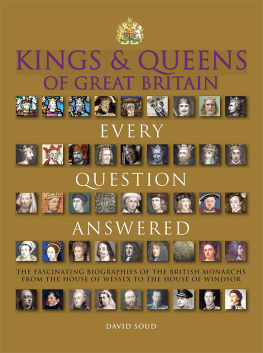
Introduction
THE IMPACT OF THE MONARCHY
T he monarchy arose alongside other social changes. Around 600, a feudal structure began to develop, with lords owning private land that was worked by serfs; clear social divisions were established between the landed and landless. At the same time, the power of the central state was growing, owing to the military conquest of territory. The king gained significance as the most important feudal lord and as a war leader, and from the time of Athelstan (925939), monarchs ruled all of England. Early kings had a huge political impact on the country, and their personality was key to the success or failure of their reign. The coronation of a new monarch was a decisive event; the sovereign would probably rule for life, and some remained at the helm for decades. Political life was quite different to the cycle of regular elections we experience in modern times.
Throughout history, the actions of individual monarchs have affected social, political and economic affairs. Strong rulers have conquered and subjugated territory, including William I in England, Edward I in Wales and Robert the Bruce in Scotland. Their impact has sometimes been unintentional; developments have occurred as by-products of policies. Social change was triggered by Henry VIIIs personal imperative for a divorce, which led to the separation of the English Church from the Catholic Church, the Reformation and the establishment of Protestantism as the state religion. In the 17th century, Charles Is inability to compromise with Parliament caused political conflict that contributed to the English Civil War and the Interregnum. After the restoration of the monarchy, Parliament substantially increased its powers.
The monarchs need for tax revenues to pay for the royal court and prosecute wars led to economic changes. Taxes were imposed initially on land, and the landowning barons who were encumbered by this taxation became determined to protect their own interests and exert some control over Crown expenditure. Over time, from the Magna Carta onwards (1215), the power of the monarchy to manage spending was gradually transferred to Parliament. From the 18th century, economic power began to shift away from the landowners who sat in the House of Lords towards the businesspeople and industrialists who occupied the House of Commons; as the latter gained ascendance, the Commons became the more powerful house in Parliament.
During the 18th and 19th centuries, constitutional monarchy developed the institution lost its executive role and adopted an advisory role in government. As the autocratic monarchies of Europe fell away in the early 20th century, the British monarchy preserved itself by carving out a ceremonial niche and becoming a focus for national identity that was cemented during two world wars. This book tells the story of a remarkably resilient institution.
Chapter 1 Saxons and Danes
800s1066
F rom the 5th to the 7th centuries, Angles, Saxons and Jutes from northern Germany established kingdoms in England. Traditionally, historians perceived their invasion as a violent takeover, but recently opinions have shifted. Although the native British people offered some resistance, many historians now see it as a less forceful conquest, marked by social integration and intermarriage with the local population. By 700, twelve main Anglo-Saxon kingdoms had formed and they fought among themselves for supremacy. It was not until the 10th century that England came under one ruler. Once in control, the Anglo-Saxon monarchs created administrative systems and laws to govern the land. In the 900s, Danish invaders persistently attacked England, raiding year after year; they finally seized the English throne the following century. In turn, their dominance was challenged by growing Norman influence.
TIMELINE OF KINGS 800s1066
800s
Egbert (802839)
Aethelwulf (839858)
Aethelbald (858860)
Aethelberht (860865/866)
Aethelred I (865/866871)
Alfred the Great (871899)
900s
Edward the Elder (899924)
Athelstan (924939)
Edmund I (939946)
Eadred (946955)
Eadwig (955959)
Edgar (959975)
Edward the Martyr (975978)
Aethelred II the Unready (9781013)
1000s
Svein Forkbeard (101314)
Aethelred II the Unready (101416)
Edmund II Ironside (1016)
Cnut (101635)
Harold I Harefoot (103540)
Hardecanute (104042)
Edward the Confessor (104266)
Harold II (1066)
ALFRED THE GREAT (871899)
The youngest of at least six children of an aristocratic family, Alfred emerged to become a powerful monarch and the best known of the Anglo-Saxon kings. The only English monarch known as the great, he mounted a fierce defence against the Danish invaders, constructed fortified towns and extensively revised Anglo-Saxon law. Alfred made steps towards the Crowns control of England, and by the 890s, his charters and coins referred to him as king of the English. He is often considered the first king of England, although he ruled only part of the country.
The Danes destructive and constructive
England was attractive to the Vikings of Denmark, for its fertile farmland and the riches of its monasteries and their longboats allowed them to reach its shores. Alfreds reign was dominated by struggles with the Danes to control England. In 871, Alfred defeated Danish forces at the Battle of Ashdown, in Berkshire, but they continued to launch attacks in Wessex. Following Alfreds victory in 878 at the Battle of Edington, near Trowbridge in Wiltshire, they made peace. The Danish raids had been hugely destructive they razed settlements and stole booty. Yet they brought advances too. The Danes introduced the axe, which was probably used for clearing forests, allowing the expansion of agriculture. They brought their sophisticated sailing technology and navigation techniques, using a sun compass to check the position of the sun, and skilful craftsmanship, making beads from melted coloured glass and elegant combs from animal bones.
Alfred burns the cakes
As author Rudyard Kipling once commented, If history were taught in the form of stories, it would never be forgotten. Many people know of King Alfred from the tale of his poor baking skills. In January 878, the Vikings invaded Alfreds base in Chippenham, and his forces were routed. The king and his men scattered around the Somerset Levels, relying on food and shelter from the locals. Alfred had taken refuge with a peasant woman, who asked him to keep an eye on her cakes baking by the fire. Consumed by his worries, he allowed the cakes to burn and was scolded by his hostess. Alfred subsequently regrouped his forces in Athelney a tiny, low-lying village in the marshes, surrounded by reeds, woods and scrubland where he planned the retaliatory assault against the Vikings in Edington.

The statue of Alfred the Great in Winchester. Winchester was the capital of the kingdom of Wessex.
Securing the kingdom
Once in control, King Alfred reorganized his army and introduced a military levy system. At any one time, half the militia were active, while the other half remained in reserve. To fight the Danes at sea, he built a naval fleet with superior ships: full nigh twice as long as the others; some had sixty oars, and some had more; they were both swifter and steadier, and also higher than the others. In 884, Alfred sent a fleet against the Danes of East Anglia and he took London in 886. He realized he could not drive the Danes out of the whole country, so he made a partition treaty. England was divided the north and east between the Rivers Thames and Tees became Danish territory, while Alfred controlled London, West Mercia and Kent. The main Danish settlements were Leicestershire, Lincolnshire, Nottinghamshire and Yorkshire; in the 11th century, the Danish area became known as the Danelaw.



















